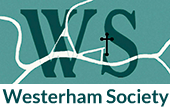Since time immemorial, people have asked the question ‘Is Westerham a village or a town’? Clearly an early settlement surrounding The Green and close to St Mary’s Church in the opening years of the 13th century would have been a village, but the granting of a market charter by Henry III in 1227 would have changed that – it would from then-on be forever a market town!
Moving on a little over four-hundred years the ‘townsfolk’ decided they would like a place to hold meetings, prepare banquets and be entertained. A letter written on August 3 1865 sets the scene for the forming of a Company which would by share capital, finance the building of a community space for the town:
‘Sir, May I take the liberty of calling your attention to the enclosed notice – This Company has been formed and registered under “The Companies Act 1862” for the erection of a Public Hall and other necessary Buildings for the accommodation of the Town and neighbourhood of Westerham etc – The shares are £10 each of which 10/- is to be paid on allotment and the remainder by separate calls of £1 unless circumstances compel the Directors to make their calls for a larger amount – the sum of £1400 has already been agreed to be subscribed. The estimated cost of the Building (including Architects Fees, Clerk of the Works salary, water supply, drains, fencing around the site of the Building, Furniture, Gas Fittings, the preliminary expenses and the Ground purchased for the site of the Building) is about £1800 – the Building is to be in the Tudor style of Architecture and will afford accommodation for a Literary Institute, Club Room, Smoking Room, Ladies Cloak Room, Housekeepers Room, Billiard Room and Lavatories etc with a Hall to hold 250 persons comfortably seated…’
The first AGM of the newly formed committee gives some background on the choosing of a site for the building ‘Had a site in or near the Market Place been open for their choice, the Directors would have gladly availed themselves of it, but a piece of ground offered to them at a reasonable price, containing the space which they required with frontage to the street of nearly 60 feet with a space 14 feet wide to be used as a Carriage Road to the main entrance of the Hall is deemed an eligible site as the town is now extending in that direction…’ The Directors selected, from a variety of plans submitted to their inspection, the plans of Messrs. W. G. Habershon and Pite of No. 38, Bloomsbury Square, as showing a large amount of accommodation and general excellence of arrangement at the least possible cost. A year later the building neared completion, though some fixtures and fittings had yet to be included, but the committee decided some revenue must be forthcoming: ‘…although the Building was formally opened on the 5th of June last, much remained to be done before the business of the Company could be concluded. The Billiard Room especially was not in sufficient condition to be opened by the middle of August, but supported as it has been by all the neighbouring Gentry and leading Tradesmen, it has proved, and the Directors trust that it will continue to be, a valuable source of Income. In addition to the Literary Institute the Directors have secured the patronage of the Amateur Choral Society, the Westerham Harmonic Society, and an Instrumental Band, who respectively hold weekly meetings In the Building for practice. The Committee Room is used by Westerham Benefit Society, an example, that, the Directors hope will be followed by the several other Societies In the Town. The Hall has thus been well used to date and is much admired…’
The Herald newspaper summarised what had been made public on March 7 1914: ‘In the February number of the Parish Magazine, the Vicar, the Rev. S. Le Mesurier, voiced the feeling of many inhabitants when he lamented the lack of a Parish Hall for Westerham. He pointed out that the Public Hall would shortly be out of private hands, and be bought through the War Office, and that it might not be available so readily, for all the purposes for which it has been used so many years. One thing he did not point out was the fact that if it becomes the property of the War Office, or of the Territorial Force Association it will not be available for political meetings of either party…' But there was light at the end of the tunnel - enter local builder (and St Mary’s Church chorister) Thomas Henry Weller - the article continued : ‘...The Vicar, however, made out such a good case that he is able, in this month’s magazine, to make a most gratifying announcement – that Mr T. H. Weller and family had generously presented to the parish a splendid site for a new hall. The site in question is opposite the new Post Office, in the London Road, next to the establishment of Mr W. Pritchard (then a wet-fish shop, now Tulsi restaurant), and it would be hard to find a more suitable position. The parishioners, generally, will be grateful to Mr Weller for the gift, and it now remains for them to do their best towards raising the sum of £1000 or £1200, which it is reckoned will be needed to build a hall and one or two useful sized rooms adjoining. It is hoped that a hall capable of accommodating an audience of some 300 will be built…’







No Comments
Add a comment about this page